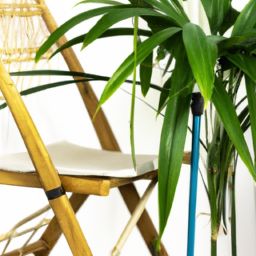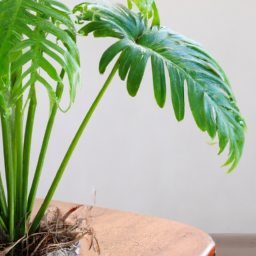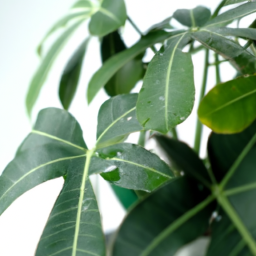
Are you looking to add a touch of the tropics to your home or garden? If so, you’ll want to make sure you know how to properly care for tropical plants. These lush and vibrant plants can bring a sense of paradise to any space, but they do require a bit of extra attention to thrive. In this blog post, we’ll cover everything you need to know about caring for tropical plants, from proper watering and sunlight to soil and fertilization. So grab your gardening gloves and let’s dive into the world of tropical plant care!
Choosing the Right Soil and Potting Mix for Tropical Plants
Understanding the Importance of Soil and Potting Mix
When it comes to caring for tropical plants, one of the most important factors to consider is the type of soil and potting mix you use. The right soil and potting mix can make a significant difference in the health and growth of your plants. Tropical plants have specific needs when it comes to soil composition, drainage, and nutrients, so it’s essential to choose the right mix to ensure they thrive.
Choosing the Right Soil for Tropical Plants
When selecting soil for your tropical plants, it’s crucial to consider their specific requirements. Tropical plants typically prefer a well-draining soil that retains moisture without becoming waterlogged. A good option is a mix that includes peat moss, perlite, and vermiculite, which provides a balance of moisture retention and drainage. Avoid heavy soils that can lead to root rot and poor growth.
In addition to drainage, tropical plants also require a soil rich in nutrients to support their growth. Look for a potting mix that includes organic matter such as compost or aged manure, which will provide essential nutrients for your plants. You can also supplement with a slow-release fertilizer to ensure your plants have access to the nutrients they need to thrive.
When repotting your tropical plants, be sure to choose a potting mix that is specifically formulated for their needs. Avoid using garden soil, as it can compact in containers and restrict root growth. Instead, opt for a high-quality potting mix designed for tropical plants to provide the best possible growing conditions.
Tips for Maintaining Healthy Soil and Potting Mix
To ensure your tropical plants continue to thrive, it’s essential to maintain healthy soil and potting mix. Regularly check the moisture levels in the soil and adjust your watering schedule as needed to prevent overwatering or underwatering. You can also top-dress your plants with fresh potting mix or compost to replenish nutrients and improve soil structure.
Additionally, consider repotting your tropical plants every 1-2 years to refresh the soil and provide room for root growth. When repotting, gently loosen the roots and remove any dead or damaged roots before placing your plant in fresh soil. This will help prevent root-bound plants and ensure your tropical plants have the space they need to thrive.
By choosing the right soil and potting mix for your tropical plants and following these tips for maintenance, you can create the ideal growing conditions for your plants to flourish. With proper care and attention to their specific needs, your tropical plants will reward you with lush foliage and vibrant blooms for years to come.

Watering and Humidity Requirements for Tropical Plants
Understanding Watering Needs
When it comes to caring for tropical plants, one of the most important factors to consider is watering. Tropical plants thrive in humid environments, so it’s important to keep their soil consistently moist but not waterlogged. Overwatering can lead to root rot, while underwatering can cause the plant to wilt and die.
To determine when your tropical plant needs water, simply stick your finger into the soil. If it feels dry to the touch, it’s time to water. Be sure to water thoroughly, allowing the water to soak through the soil and drain out of the bottom of the pot. This will help prevent water from pooling at the roots and causing rot.
It’s also important to use room temperature water when watering your tropical plants. Cold water can shock the roots, while hot water can scald them. If possible, use rainwater or distilled water to avoid any chemicals or minerals that may be present in tap water.
Creating the Right Humidity Levels
Tropical plants thrive in high humidity environments, so it’s important to mimic their natural habitat as much as possible. If you live in a dry climate, you may need to take extra steps to increase the humidity around your plants.
One easy way to increase humidity is to place a humidifier near your tropical plants. You can also create a humidity tray by filling a shallow tray with pebbles and water, then placing your plant on top. As the water evaporates, it will increase the humidity around the plant.
Misting your tropical plants with water can also help increase humidity, but be sure to do it in the morning so that the leaves have time to dry before nightfall. Wet leaves at night can lead to fungal diseases.
Another option is to group your tropical plants together. As they transpire, they release moisture into the air, creating a mini greenhouse effect that can help increase humidity levels.
Monitoring and Adjusting
It’s important to monitor the moisture levels of your tropical plants regularly and adjust your watering and humidity routines as needed. Keep an eye on the leaves of your plants – if they start to yellow or brown, it may be a sign that they are not getting enough water or humidity.
Remember that each tropical plant is unique and may have slightly different watering and humidity requirements. Do some research on the specific plants you have in your collection to ensure they are getting the care they need.
By following these tips and paying close attention to the needs of your tropical plants, you can create a lush and thriving indoor jungle that will bring a touch of the tropics to your home.

Common Pests and Diseases in Tropical Plants and How to Prevent Them
Pests
When it comes to caring for tropical plants, dealing with pests is often a common challenge that many gardeners face. Some of the most common pests that can affect tropical plants include aphids, mealybugs, spider mites, and scale insects. These pests can cause damage to the plants by feeding on their leaves, stems, and roots, leading to stunted growth, yellowing leaves, and even death if left untreated.
One of the best ways to prevent pests from infesting your tropical plants is to regularly inspect them for any signs of infestation. Look for small insects, webs, or sticky residue on the leaves and stems, as these are all indicators that pests may be present. If you do spot any pests, it’s important to take action immediately to prevent them from spreading to other plants.
There are several natural remedies that can help control pests on tropical plants. For example, you can use a mixture of water and dish soap to create a homemade insecticidal soap that can be sprayed on the plants to kill pests on contact. You can also introduce beneficial insects, such as ladybugs or lacewings, to help control pest populations in your garden.
In addition to natural remedies, you can also use chemical pesticides to control pests on tropical plants. However, it’s important to use these products sparingly and according to the manufacturer’s instructions to avoid harming the plants or beneficial insects in your garden. Always read the label carefully before applying any pesticide and wear protective gear, such as gloves and a mask, to protect yourself from exposure.
Diseases
In addition to pests, tropical plants are also susceptible to a variety of diseases that can affect their health and vitality. Some common diseases that can affect tropical plants include fungal infections, bacterial infections, and viral diseases. These diseases can cause symptoms such as wilting, yellowing leaves, and black spots on the foliage, which can ultimately lead to the death of the plant if left untreated.
To prevent diseases from affecting your tropical plants, it’s important to practice good garden hygiene. This includes removing any dead or diseased plant material from the garden, as these can harbor pathogens that can spread to healthy plants. You should also avoid overwatering your plants, as excess moisture can create the perfect conditions for fungal and bacterial infections to thrive.
If you do notice any signs of disease on your tropical plants, it’s important to take action quickly to prevent it from spreading. You can use fungicides or bactericides to treat fungal and bacterial infections, respectively, but it’s important to use these products as a last resort and only if other methods have failed. Always follow the manufacturer’s instructions when applying any chemical treatments and wear protective gear to avoid exposure.
In addition to chemical treatments, you can also use natural remedies to help prevent and control diseases in tropical plants. For example, you can apply a mixture of neem oil and water to the plants to help prevent fungal infections, or use a garlic spray to deter pests and pathogens. Regularly inspecting your plants for any signs of disease and taking prompt action when necessary can help keep your tropical plants healthy and thriving.
Conclusion
Caring for tropical plants can be a rewarding experience, but it’s important to be aware of the common pests and diseases that can affect them. By regularly inspecting your plants, practicing good garden hygiene, and using natural remedies and chemical treatments when necessary, you can help prevent pests and diseases from damaging your tropical plants. Remember to always read the label on any pesticide or fungicide you use, and wear protective gear to avoid exposure. With proper care and attention, your tropical plants can thrive and bring beauty to your garden for years to come.
Here are the Essential Points
Tropical plants are a beautiful addition to any home, but they require a bit of extra care to thrive in non-tropical climates. One important aspect of caring for tropical plants is ensuring they receive adequate sunlight. Most tropical plants require bright, indirect light to grow properly, so placing them near a sunny window or using grow lights can help mimic their natural habitat.
In addition to light, tropical plants also need high humidity levels to thrive. To increase humidity, consider placing a humidifier near your plants or placing a tray of water and pebbles beneath them. Regular misting can also help keep the air around your plants moist. By providing the right amount of light and humidity, you can ensure your tropical plants stay healthy and vibrant all year round.
Your Burning Questions Answered:
Q1: What are some general care tips for tropical plants?
A1: To care for tropical plants, make sure they are placed in a location with bright, indirect sunlight. Keep the soil evenly moist but not waterlogged, and provide high humidity by misting the leaves regularly.
Q2: How often should I water my tropical plants?
A2: The frequency of watering tropical plants will depend on factors like the plant species, the size of the pot, and the environment. Generally, it’s best to water when the top inch of soil feels dry to the touch.
Q3: Do tropical plants need fertilizer?
A3: Yes, tropical plants benefit from regular fertilization during their growing season, typically in the spring and summer. Use a balanced liquid fertilizer diluted to half strength to avoid over-fertilizing.
Q4: How can I increase humidity for my tropical plants?
A4: To increase humidity for tropical plants, you can place a humidifier near them, group plants together to create a microclimate, or place a tray of water with pebbles underneath the plants to evaporate and provide moisture.
Q5: What are some common pests that affect tropical plants?
A5: Common pests that can affect tropical plants include spider mites, mealybugs, aphids, and scale insects. Regularly inspect your plants for any signs of pests, and treat infestations promptly with insecticidal soap or neem oil.

James Wong is a renowned ethnobotanist, plant scientist, and local television presenter. With a passion for demystifying plant science, he is known for translating complex botanical concepts into practical advice for everyday plant enthusiasts. James’s expertise spans from traditional gardening to cutting-edge plant technologies, making his insights accessible and informative.


